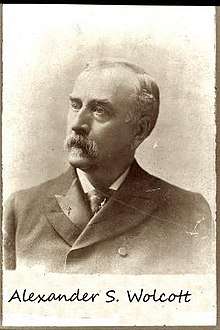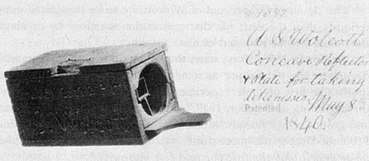Alexander S. Wolcott
Alexander Simon Wolcott (also Alexander S. Wolcott and A. S. Wolcott; June 14, 1804 – March 26, 1844) was a maker of medical supplies. He was a nineteenth-century pioneer photographer and inventor. He made with John Johnson the world's first commercial photography portrait studio and patented the first US camera that made photographs.
Alexander S. Wolcott | |
|---|---|
 circa 1843 | |
| Born | June 14, 1804 |
| Died | March 26, 1844 (aged 39) |
| Nationality | American |
| Occupation | Manufacturer |
| Known for | World's first portrait studio |
Notable work | First U.S. patented camera |
Early life
Wolcott was born on June 14, 1804, in New London, Connecticut.[1] He was the son of Alexander Wolcott, Sr. and Joanne (Paull) Wolcott.
Photography


Wolcott lived in New York City in the 1830s and made dental supplies for a living.[3][4] He worked in the mechanics of designing instruments that used optics.[5] In 1839 he became an associated with Johnson, a jeweler and watchmaker's assistant.[6] Johnson took to Wolcott on October 6, 1839, a copy of the specifications on Daguerre's method of capturing a likeness of a person and storing on a permanent plate that would hold the picture indefinitely.[7][8] They made a camera that day based on Daguerre's method and started experimenting with it.[1][9]
Wolcott improved on Daguerre's lens camera by making a camera that used a mirror instead.[3][10] On October 7, 1839, Wolcott made the first portrait in the world with a prototype of his daguerreotype camera when he took a picture of his partner Johnson.[11][12][13][14] Wolcott patented it on May 8, 1840 (US #1,582).[15] It became known as "Wolcott's camera" and referred to as the "mirror camera."[16] It was the first US patent in photography.[18]
Wolcott and Johnson started using their camera on March 4, 1840, in a New York City business on Broadway called the "Daguerreian Parlor" that made commercial portraits in a studio.[19][20][21][22] It was in the Granite Building.[23] They had opened the world's first commercial daguerreotype gallery, a portrait photography studio.[9][24][25][26] By June they had a branch studio in Washington D.C., which was operated by John G. Stevenson.[27]
Wolcott's patented camera used a polished concave mirror to reflect the focused light onto a photosensitive plate that was less than a half inch square. The pictures were not a negative image of reverse colors, but a correct positive image that did not require reversion of the image.[28] The size of the photo-sensitive plate was eventually increased to just over two square inches that they could make a likeness image, because of their refined mechanical lighting techniques.[14]
Wolcott and Johnson continued to improve their photography techniques as time went on. Wolcott improved his photo-sensitive plate and came up with a chemical "accelerator" that was a mix of bromide and chloride. This along with improved polished silver plates earned them a second U.S. patent in photography in December 1841, designated #2,391. They also came up with new innovative studio lighting by designing special outdoor mirrors that provided more light to the inside studio itself for faster better quality portrait pictures.
Death
Wolcott died on November 10, 1844, at age 39 in Stamford, Connecticut.[1][28]
References
- Falk 1999, p. 3116.
- KodakMuseum 1989, p. 21.
- McGraw-Hill 1969, pp. 136–137.
- Newhall 1976, p. 156.
- Gillespie 2016, p. 138.
- APHA 1984, p. 54.
- Heathcote 2002, pp. 87–89.
- Newhall 1976, p. 25.
- Signals 1953, p. 18.
- Watson, Elmo Scott (June 13, 1940). "Again is Raised the Question of Who Made the First Camera in the U.S." The Times-Independent. Moab, Utah. p. 2 – via Newspapers.com

Wolcott who was an instrument maker and manufacturer of dental supplies took a daguerreotype of his partner John Johnson on October 7, 1839, according to Taft and this was the first photographic portrait.
- "Who made the first good daguerreotype!". Democrat and Chronicle. Rochester, New York. February 1, 1883. p. 2 – via Newspapers.com

- Watson, Elmo Scott (November 24, 1938). "Next Year Will Be Celebrated The Centennial of Photography". The Times-Independent. Moab, Utah. p. 3 – via Newspapers.com

- McDarrah 1999, p. 541.
- Macintosh 1843, pp. 275–283.
- Ikenson 2012, p. 15.
- "Patent issued". New Castle News. New Castle, Pennsylvania. June 8, 1978. p. 15 – via Newspapers.com

- Hirsch 2017, p. 32.
- Gernsheim 1986, p. 31.
- Glenner 1990, p. 11.
- Kane 1997, p. 414.
- Gillespie 2016, p. 139.
- Schimmelman 2002, p. 3.
- Daguerreian Society 2008, p. 105.
- Baird 1975, p. 1.
- Taft 1938, p. 460.
- "Mr. Alexander S. Wolcott". The Times-Picayune. New Orleans, Louisiana. November 20, 1844. p. 2 – via Newspapers.com

Sources
- APHA (1984). Photographica Journal. American Photographic Historical Association.CS1 maint: ref=harv (link)
- Baird, Joseph Armstrong (1975). Images of El Dorado.
Alexander S. Volcott and John Johnson opened the first Daguerreian Parlor in New York in March 1840.
CS1 maint: ref=harv (link) - Daguerreian Society (2008). The Daguerreian Annual. The Society.CS1 maint: ref=harv (link)
- Falk, Peter H. (1999). Who was who in American Art. Sound View Press. ISBN 978-0-932087-55-3.CS1 maint: ref=harv (link)
- Gernsheim, Helmut (1986). Concise History of Photography. Courier Corporation. ISBN 978-0-486-25128-8.
This shortened the exposure to 3–5 minutes, and allowed Wolcott and Johnson to open the world's first Daguerreian Parlor in New York at the beginning of March 1840.
CS1 maint: ref=harv (link) - Gillespie, Sarah Kate (12 February 2016). The Early American Daguerreotype: Cross-Currents in Art and Technology. MIT Press. ISBN 978-0-262-03410-4.CS1 maint: ref=harv (link)
- Glenner, Richard A. (1990). The American dentist. Pictorial Histories Pub. Co. ISBN 978-0-929521-05-3.
He also developed a system of photographic studio lighting in February 1840 and on March 13, 1840 opened the world's first commercial photographic studio. Wolcott made dental instruments and equipment with his partner, John Johnson.
CS1 maint: ref=harv (link) - Hannavy, John (16 December 2013). Encyclopedia of Nineteenth-Century Photography. Routledge. ISBN 978-1-135-87327-1.CS1 maint: ref=harv (link)
- Heathcote, Bernard & Pauline (2002). A faithful likeness. B. & P. Heathcote. ISBN 978-0-9541934-0-9.CS1 maint: ref=harv (link)
- Hirsch, Robert (7 April 2017). Seizing the Light. Taylor & Francis. ISBN 978-1-317-37183-0.
Alexander S. Wolcott (1804–1844) and John Johnson (1813–1871) opened what the March 4, 1840, New York Sun exclaimed was “the first daguerreotype gallery for portraits,” which started before the daguerreotype system had fully evolved.
CS1 maint: ref=harv (link) - Ikenson, Ben (2012). Patents: Ingenious Inventions. Hachette Books. ISBN 978-1-60376-272-4.
In 1840, Alexander S. Wolcott became the first US person to receive a patent for a camera that took photographs. Wolcott and a partner opened the world's first photo portrait studio in New York just two months before this patent was issued.
CS1 maint: ref=harv (link) - Kane, Joseph Nathan (1997). Famous first facts. H.W. Wilson. ISBN 978-0-8242-0930-8.
The first commercial photography studio in the world was opened on March 4, 1840, in New York City by Alexander S. Wolcott and John Johnson. On May 8, 1840, Wolcott received the first photography patent, for 'a method of taking likenesses by means of a concave reflector and plates so prepared that luminous or other rays will act thereon.'
CS1 maint: ref=harv (link) - KodakMuseum (June 1989). The Story of popular photography. Trafalgar Square Pub. ISBN 978-0-943955-15-5.CS1 maint: ref=harv (link)
- Macintosh (1843). Repertory of patent inventions. Macintosh.CS1 maint: ref=harv (link)
- McDarrah, Gloria S. & Fred W & Timothy S. (1999). The Photography Encyclopedia. Schirmer Books. ISBN 978-0-02-865025-8.
Wolcott and a partner opened the first professional daguerreotypist studio in America when they set up shop in New York City in 1840. The inventor of numerous devices for improving the daguerrotype process, he is generally considered the first to make a portrait, in October 1839.
CS1 maint: ref=harv (link) - McGraw-Hill (1969). Focal Encyclopedia of Photography. McGraw-Hill.CS1 maint: ref=harv (link)
- Newhall, Beaumont (1976). The Daguerreotype in America. Courier Corporation. ISBN 978-0-486-23322-2.CS1 maint: ref=harv (link)
- Schimmelman, Janice G. (2002). American Photographic Patents 1840–1880. Carl Mautz Publishing. ISBN 978-1-887694-21-6.CS1 maint: ref=harv (link)
- Signals (1953). Signals. The Association.CS1 maint: ref=harv (link)
- Taft, Robert (1938). Photography and the American Scene. Acls History E Book Project.CS1 maint: ref=harv (link)